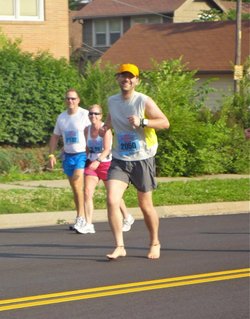running barefoot
 Humans have been running barefoot or in minimal footwear successfully for millenia while modern running shoes have only been around for a few decades.
Humans have been running barefoot or in minimal footwear successfully for millenia while modern running shoes have only been around for a few decades.
When it comes to barefoot activity, most people have heard of the barefoot running movement.
While there's very little research comparing running completely barefoot to wearing modern footwear, it's compelling to know that people have been running -- and running very long distances and quick paces -- for centuries with little or nothing on their feet and with little injury. Meanwhile, runners today suffer all kinds of injuries from shin splints to knee pain to stress fractures.
Remember that bare feet are the innate condition of the body. Also remember that many species of animals run perfectly well -- and without injury -- without the shoes we humans usually wear. If humans are "born to run" as many people believe, it seems rational to think that we should consider running in our innate condition or with as little added to our feet as absolutely necessary.
Anyone transitioning to barefoot running -- but who has worn shoes most of their lives -- needs to be very careful. The biomechanics of running without shoes are very different than running with them. Someone who has a medical condition that causes peripheral neuropathy or similar disorders must be especially cautious and carefully weigh the risks involved.
Many people run completely barefoot successfully, and they are able to do it because they approached it correctly.
Babies must crawl before they can walk, and they must walk before they run. Likewise, anyone interested in barefoot running should walk barefoot for quite a while before they ever start running. This will help ensure that the structures of the feet, ankles, and legs are best prepared for the forces and biomechanics involved.
Running without shoes also involves the same care needed to run with shoes. Other health complications that may cause problems need to be ruled out and treated. A healthy diet and cross-training exercises will also improve the chances for success.
Let's be clear: Research does not show whether running barefoot or with shoes is better. History tells us, however, that someone has a good chance of running barefoot without injury if they are careful and take prudent steps to be successful.




